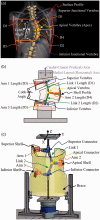A mechanical analog thoracolumbar spine model for the evaluation of scoliosis bracing technology
- PMID: 31191960
- PMCID: PMC6531798
- DOI: 10.1177/2055668318809661
A mechanical analog thoracolumbar spine model for the evaluation of scoliosis bracing technology
Abstract
Introduction: Thoracolumbar braces are used to treat Adolescent Idiopathic Scoliosis. The objective of this study was to design and validate a mechanical analog model of the spine to simulate a thoracolumbar, single-curve, scoliotic deformity in order to quantify brace structural properties and corrective force response on the spine.
Methods: The Scoliosis Analog Model used a linkage-based system to replicate 3D kinematics of spinal correction observed in the clinic. The Scoliosis Analog Model is used with a robotic testing platform and programmed to simulate Cobb angle and axial rotation correction while equipped with a brace. The 3D force and moment responses generated by the brace in reaction to the simulated deformity were measured by six-axis load cells.
Results: Validation of the model's force transmission showed less than 6% loss in the force analysis due to assembly friction. During simulation of 10° Cobb angle and 5° axial rotation correction, the brace applied 101 N upwards and 67 N inwards to the apical connector of the model. Brace stiffness properties were 0.5-0.6 N/° (anteroposterior), 0.5-2.3 N/° (mediolateral), 23.3-26.5 N/° (superoinferior), and 0.6 Nm/° (axial rotational).
Conclusions: The Scoliosis Analog Model was developed to provide first time measures of the multidirectional forces applied to the spine by a thoracolumbar brace. This test assembly could be used as a future design and testing tool for scoliosis brace technology.
Keywords: Scoliosis; analog model; brace; loading/response model; spinal orthosis.
Conflict of interest statement
The author(s) declared no potential conflicts of interest with respect to the research, authorship, and/or publication of this article.
Figures







Similar articles
-
Long-term results after brace treatment with Progressive Action Short Brace in adolescent idiopathic scoliosis.Eur J Phys Rehabil Med. 2021 Jun;57(3):406-413. doi: 10.23736/S1973-9087.20.06129-8. Epub 2020 Sep 29. Eur J Phys Rehabil Med. 2021. PMID: 32990686
-
Boston vs. Providence brace in treatment of Adolescent Idiopathic Scoliosis.Stud Health Technol Inform. 2021 Jun 28;280:179-183. doi: 10.3233/SHTI210462. Stud Health Technol Inform. 2021. PMID: 34190083
-
Clinical effect of continuous corrective force delivery in the non-operative treatment of idiopathic scoliosis: a prospective cohort study of the TriaC-brace.Eur Spine J. 2008 Feb;17(2):231-9. doi: 10.1007/s00586-007-0513-9. Epub 2007 Oct 10. Eur Spine J. 2008. PMID: 17926071 Free PMC article. Clinical Trial.
-
Evaluation of the efficiency of the Chêneau brace on scoliosis deformity : A systematic review of the literature.Orthopade. 2018 Mar;47(3):198-204. doi: 10.1007/s00132-018-3529-4. Orthopade. 2018. PMID: 29392350 English.
-
[Treatment of lumbar and dorso-lumbar scoliosis using the Boston orthosis and the 3-valve orthosis. Comparative study of the results in the frontal and horizontal planes].Rev Chir Orthop Reparatrice Appar Mot. 1988;74(6):569-75. Rev Chir Orthop Reparatrice Appar Mot. 1988. PMID: 3070653 Review. French.
Cited by
-
The Biomechanics of Spinal Orthoses for Adolescent Idiopathic Scoliosis: A Systematic Review of the Controlling Forces.Bioengineering (Basel). 2024 Dec 8;11(12):1242. doi: 10.3390/bioengineering11121242. Bioengineering (Basel). 2024. PMID: 39768060 Free PMC article. Review.
References
-
- Altaf F, Gibson A, Dannawi Z, et al. Adolescent idiopathic scoliosis. BMJ 2013; 346: f2508. - PubMed
-
- Gallo D. Control of idiopathic scoliosis treatment in 147 patients while using the RSC brace. JPO J Prosthet Orthot 2011; 23: 69–77.
LinkOut - more resources
Full Text Sources
Other Literature Sources

